The Hindenburg Omen: A Detailed Analysis
The Hindenburg Omen is a technical indicator named after the German passenger airship that tragically crashed in 1937. Traders and analysts often refer to this ominous-sounding signal as a potential predictor of stock market crashes. However, there is much debate within the financial community about the accuracy and reliability of the Hindenburg Omen.
1. What is the Hindenburg Omen?
The Hindenburg Omen is characterized by a set of specific criteria that need to be met in order to signal a potential market downturn. These criteria include a high number of stocks hitting new highs and lows simultaneously, along with other technical indicators related to market breadth and volume. When these conditions are met, the Hindenburg Omen is said to have been triggered.
2. Effects of the Hindenburg Omen
Many traders and investors believe that the Hindenburg Omen is a strong signal of an impending stock market crash. They argue that the simultaneous occurrence of new market highs and lows indicates underlying market weakness and instability. As a result, some market participants use the Hindenburg Omen as a cautionary sign to adjust their investment strategies or even exit the market altogether.
However, critics of the Hindenburg Omen argue that it is a flawed and unreliable indicator. They point out that the criteria for triggering the signal can be arbitrary and that historical data does not consistently support the predictive power of the Hindenburg Omen. Critics also caution against making investment decisions based solely on this indicator, as it may lead to missed opportunities or unnecessary panic selling.
3. Duration of the Hindenburg Omen
One of the key criticisms of the Hindenburg Omen is its lack of specificity regarding the timing of market crashes. The indicator may be triggered multiple times within a short period, leading to confusion and uncertainty among investors. Additionally, the duration of the signal is often limited, with some occurrences followed by market stability or even continued growth.
Despite its limitations, some traders and analysts continue to monitor the Hindenburg Omen as part of their technical analysis toolkit. They recognize that while the indicator may not be a foolproof predictor of market crashes, it can still provide valuable insights into market sentiment and breadth. By combining the Hindenburg Omen with other technical indicators and fundamental analysis, investors may be better equipped to make informed decisions about their portfolios.
In conclusion, the Hindenburg Omen remains a controversial and divisive topic within the financial community. While some see it as a powerful warning sign of market downturns, others question its validity and reliability. As with any technical indicator, investors should approach the Hindenburg Omen with caution and conduct thorough research before making investment decisions based on its signals.
